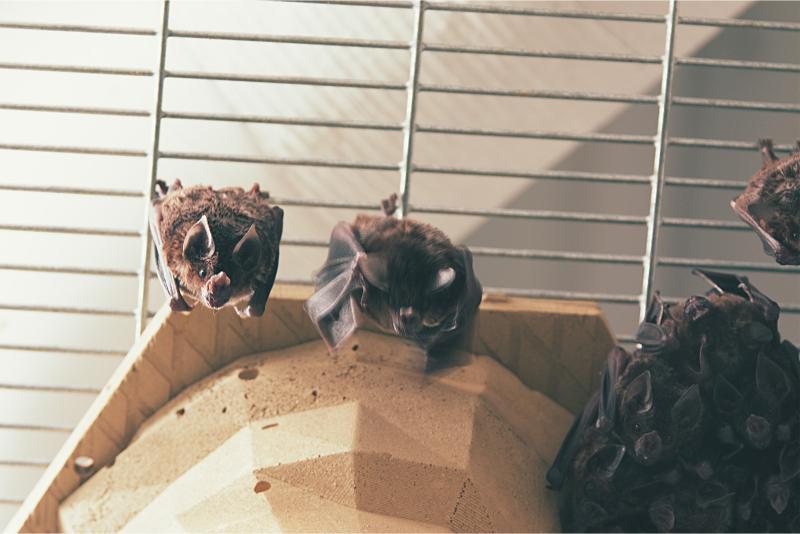Designing Stalactites for the Bat Habitat
Driscoll, who will graduate this year with a major in geography and minors in environmental science and construction management, started working with the Innovation Lab—a group of experiential learning spaces housed in the Richie School of Engineering and Computer Science—his first year at DU.
“It was a place on campus where I felt my creativity, my drive and my hard work could see a direct and pretty quick impact,” he said.
This project was run through the microFactory, where students in the Lab use the skills they’ve learned to build custom products for clients. Students handle every part of the transaction, from customer service and writing proposals, to design and manufacturing.
A team from the Innovation Lab visited the Denver Zoo and worked with Katie Vyas and Andy Schertz, the Curator of Ectotherms and Animal Ambassadors, to determine the design and materials specifications for stalactites. These would be attached to the ceiling to provide cover and an environment closer to the bats’ natural habitat for their stay in the veterinary enclosure. Then Driscoll worked together with Ryan Farrell, Technology Lab Facilitator, to build a 3D printed model. Once the model was approved, Zac Abero, Co-lead Woods & Plastics Lab, joined in to help create a mold that would be used to manufacture the full run of stalactites.
It was Dr. Vyas’ first time working with the Innovation Lab, and he was impressed.
“The entirety of the deliverables and budgeting was really managed by these undergraduate students,” Dr. Vyas said. “It was a really cool experience and eye opening to see the type of resources that are available here to students at DU.”
Measuring the Impact of Habitat Updates
Along with the creation of the stalactites, the Denver Zoo’s partnership with DU provided an opportunity to study the impact of the updates, giving the staff the information they need to make evidence-based decisions.
“It's important for them to know whether the conditions in which the animals are living are meeting the animals’ goals, specifically when it comes to welfare,” Dr. Vyas said. “This was a good opportunity to help them continue meeting their goals to have a really high standard of animal wellbeing.”
Dr. Vyas wanted an undergraduate student to have the opportunity to join the research team for the project and notified his students that he was recruiting for the position. Luckily for fourth-year integrated science major Sierra McKinney, Teaching Associate Professor in the Biology Department Dr. Barbekka Hurtt thought of the position when McKinney expressed her interest in veterinary school.
“It came up super casually, and it has turned into this big project that is very exciting because we have an opportunity to be published in a journal,” McKinney said.
McKinney had recently made it a goal to apply for veterinary school, and said she thought this opportunity would be a good way to start getting more experience working with animals. She applied for and received a DU Undergraduate Research Grant for the project. Then she got to work.
“I would go to the zoo two or three times a month and look at the video recordings they had set up,” McKinney said.
She’d then take screenshots of specific times and look at the location and spread of the bats during those time periods.
“I’m taking ecology classes right now and we’re learning about behavioral functions in animals,” McKinney said. “It’s cool learning about these things and then also being able to implement them into my research outside of school.”
Data collection began before the stalactites were installed to collect a set of control data. Along with the behavioral data collected on video, Denver Zoo staff took periodic measurements of stress hormones in the bats to determine whether the change in environment improved stress levels for the animals. McKinney is now working with Mykaela Tanino-Springsteen, recent DU graduate and currently a National Science Foundation Research Experience Post-Baccalaureate Student, to analyze the data and write a manuscript for publication.
While the team will not know the final results of their research until they finish analyzing the data, subjectively they have seen what appears to be some impact.
“From what we hear and see from the zookeepers at Denver Zoo as well as from our own images, it seems as if the bats were getting accustomed to using the stalactites as shelter,” Dr. Vyas said. He went on to say that they’ll need the final data analysis to learn whether it was a statistically significant behavioral change, and whether it had an impact on the bats’ stress levels.
Sharing Findings
One of Dr. Vyas’ goals for this project was to involve students in all aspects of scientific work that has real-life impact.
“We wanted to take the entire process of science from developing ideas, answering questions to disseminating information in different ways,” he said. “The hope is to really use this as a jumping point for undergraduates to build their resume and professional development.”
Along with the research paper, which the team plans to publish this year in a journal used by practitioners in the zoo field, they would like to give a talk at the 2023 DU Undergraduate Showcase in May.
“[This project gives students] an idea of how science works full circle, from planning stages to using prior data, to collaborating with working professionals,” Dr. Vyas said. “The hope is that when undergraduates leave DU with these experiences, they’re ready for and better acclimated to these types of conditions in a professional world.”
Dr. Vyas calls this the first of many collaborations. He said he hopes to find a variety of ways that DU students can provide their skills and the access they have to resources like the Innovation Lab, and in return the zoo can be “a venue that is a unique place for students to go experience and work with wildlife in a city environment.”



